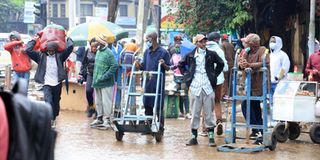Nairobi bears the brunt of deadlier Covid-19 wave in Kenya

Nairobi residents are pictured in the town centre, some with their masks off, on November 20, 2020. Wearing a mask is one of the primary ways to prevent the spread of Covid-19.
What you need to know:
- Kibra leads in the number of listed deaths, with 161 cases, almost double the number registered by other sub-counties in the county.
Nairobi County continues to bear the biggest burden of Covid-19 infections, recording 247 deaths between January and April alone, the majority of the victims being men.
According to the Nairobi Covid-19 pandemic data outlook report, by the Nairobi Metropolitan Services (NMS), the capital city has recorded 931 deaths since last March, when Kenya confirmed its first case of the disease.
Of those deaths, 191 were health care workers.
Kenya announced its first Covid-19 case on March 19, 2020. A second wave of infections followed months later while the third wave was officially announced on March 10 this year by the Health ministry.
It was when infections peaked that President Uhuru Kenyatta announced tougher measures to contain the pandemic, declaring five counties - Nairobi, Machakos, Kiambu, Nakuru and Kajiado - disease infested.
Key among the measures were a cessation of movement order and expanding the nighttime curfew from 10pm to 4am, to 8pm to 4am.
The measures will be reviewed at the end of May.
Deaths: Kibra leading
Kibra leads in the number of listed deaths, with 161 cases, almost double the number registered by other sub-counties in the county.
The April 21 report shows that 487 of those who died had underlying medical conditions while nine died directly from the virus. Cases of missing data numbered 435.
Of that number of people who have died in Nairobi, 647 were male and 284 female. Kenya’s death toll as of Monday was 2,643.
Dagoretti North came second after Kibra with 102 deaths and was followed by Lang’ata with 71 and Dagoretti South with 70.
Embakasi South has more cases of community-reported suspected Covid-19 deaths compared to those that have been line-listed.
“Westlands, Dagoretti North and Lang’ata have also reported a significant number of community-reported suspected Covid-19 deaths, particularly from the time the Ministry of Health stopped covering costs for Covid-19 patients requiring admission in TX and isolation facilities,” says the report.
Rising infections
The report also noted a spike in the number of positive cases in Nairobi, which were at least 28,889 between January and April.
It said Nairobi has reported at least 70,753 cases since the pandemic struck, out of the 156,981 record countrywide by Monday.
Since January, a total of 1,108 students and 211 teachers have tested positive for Covid-19, compared to 1,870 students and 407 teachers since March last year.
Over the same period, a total of 1,060 health workers tested positive for Covid-19, among them 331 nurses, 192 doctors and 159 community health workers.
Others infected were 64 pharmacists, 68 clinical officers, 81 laboratory technicians, 19 public health officers, 19 radiographers and 13 physiotherapists, among others.
Vulnerable groups
About two thirds - 42,075 or 61 per cent, - of the patients were male, whereas the majority of cases were in age group 25-49, with the caseload peaking among people aged 30-34 years , regardless of gender.
The vulnerable group - those aged 50 and above - accounted for 21 per cent of the cases (15,402), while the 10-25 age group accounted for 9,801 (14 percent). Those aged below 10 years accounted for 3,500 or five per cent of the cases.
In terms of the number of cases, Lang’ata leads in Nairobi with 8,925, followed by Westlands with 7,037, Kibra with 5,990, Starehe 4,656, Embakasi East 3,806, Embakasi West 3,683, Kasarani 3,612, Makadara 3,599 and Kamukunji 3,561.
Ruaraka had 3,017 infections, Roysambu 3,014, Embakasi South 2,799, Embakasi Central 2,791, Mathare 2,521, Dagoretti South 2,552 and Embakasi North 2,133.




